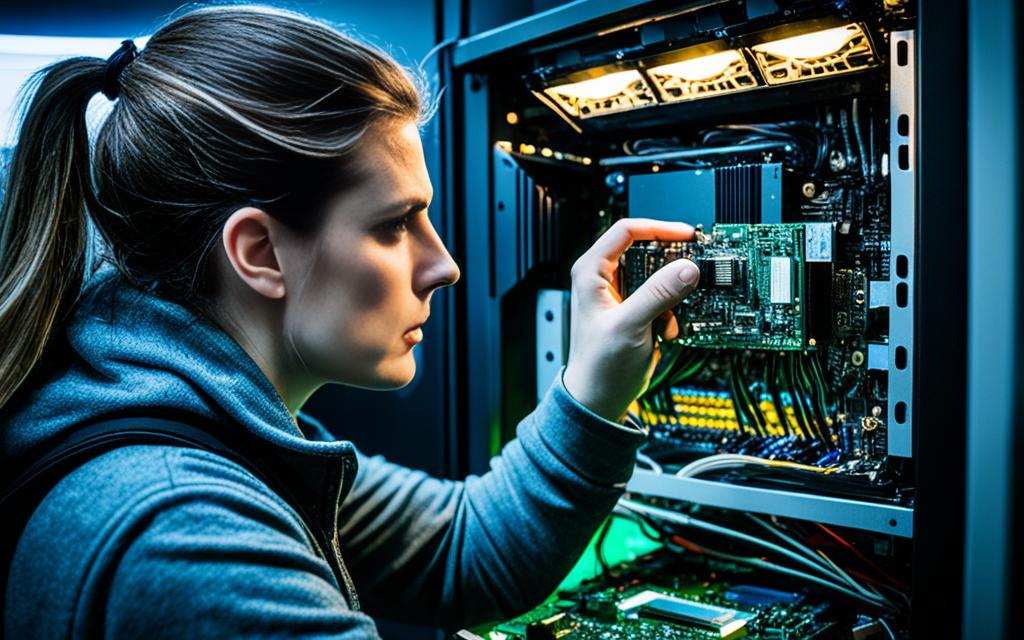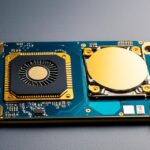Table of Contents
Finding out how to check SSD slots in your system is key for those wanting to boost their computer’s storage. With tasks like video editing and gaming needing more storage, it’s crucial to know your laptop or PC’s SSD slot capacity before buying anything. This will not only save you time but also improve your computer’s performance by ensuring you pick the correct parts. By looking at manufacturer details and how the motherboard is designed, you’ll understand how much you can upgrade. Checking SSD slot compatibility is also important to prevent any unpleasant surprises. For help choosing the right SSD, the Crucial Upgrade Selector offers advice on compatible SSDs and boosting performance1.
Key Takeaways
- Knowing the number of SSD slots helps maximise performance upgrades.
- Compatibility is key in upgrade decisions for your laptop or PC.
- SATA SSDs are slower than NVMe, affecting your upgrade options.
- The Crucial Upgrade Cp Selector makes choosing easier.
- A physical check may be required to see all available SSD slots.
The Importance of SSD Slots in Your Computer
In today’s world, knowing about SSD slots is crucial. SSD technology has changed the game by offering speed and efficiency. This is something HDDs can’t compete with. SSDs use NAND flash memory, which allows for quicker access to data and improves your computer’s response time.
Understanding SSD Technology
SSD technology has changed how we save and access our files. Unlike HDDs, which have moving parts, SSDs use flash memory. This leads to faster startup times and less waiting around when you’re using your computer. It’s especially useful for activities that need quick data access like gaming, video editing, and programming.
Benefits of Having Multiple SSD Slots
Having several SSD slots in your computer comes with great benefits. It lets you boost computer performance by setting up different storage options. For example, putting your operating system on one SSD and larger files on another makes your system faster and more responsive because it reduces the time needed to access data.
This setup is also good for multitasking, helping your computer handle tough software smoothly. Desktops made for high-demand tasks often have several SSD slots. They meet the need for more storage without slowing down your system. Imagine a powerful workstation that needs a lot of space; having many SSD slots is essential.
The trend towards SSDs is clear, and those looking to improve their computer should think about systems with multiple SSD slots. More slots not only offer extra space for storage but also make data more secure than on HDDs, which can fail mechanically. Getting a computer with several SSD slots is a wise move for those who need strong performance and storage capacity, whether it’s for work or gaming.
New motherboard designs are making it easier to add more storage, changing the computing experience. To learn about checking your system for SSD slots, visit how to check your system’s SSD slots2.
Different Types of SSD Interfaces
SSD technology varies mainly due to the interfaces they use. It’s crucial to know the differences between SSD interfaces, like SATA and NVMe, to choose the right one. This choice impacts how well they meet your speed needs.
Understanding SATA vs NVMe SSDs
SATA SSDs connect through the Serial Advanced Technology Attachment interface. They are known for being affordable and compatible. Mostly, they use 2.5” form factors, fitting easily into various computers. However, they can only transfer data up to 6Gbps, which is less than newer SSDs.
NVMe SSDs, on the other hand, use PCIe slots for connection. They offer speeds up to 20Gbps. This is much faster than SATA SSDs. In fact, they can provide speeds up to 3,500MB/s on up-to-date motherboards3. For heavy tasks like video editing and moving large files, NVMe SSDs perform three to ten times better than SATA ones4.
M.2 SSDs are made for thin laptops, offering speeds of 3,500MB/s, while SATA SSDs max out at around 600MB/s5. But, M.2 SSDs often cost more, especially for bigger storage sizes.
PCIe Slots: An Overview
PCIe slots are vital for NVMe SSDs, letting them communicate quicker with the motherboard. As computing moves to NVMe, the value of these slots grows. PCIe Gen4 options can reach speeds up to 16GB/s. SATA SSDs, stuck with older tech, can’t match this.
Though NVMe SSDs boost performance significantly, limitations may arise on motherboards with few PCIe slots. Choosing the right product, therefore, is critical, especially for gamers and professionals seeking top performance3.
How to See How Many SSD Slots I Have
Knowing how many SSD slots your computer has is key for boosting its speed. Luckily, you can find this out with tools like the Windows Task Manager and the system information tool.
Using Windows Task Manager to Check SSD Slots
To see SSD slots in the Windows Task Manager, first open the app. Right-click on the taskbar and choose “Task Manager” or press Ctrl + Shift + Esc. Once it’s open, go to the Performance tab. You’ll see a “Disk” section here. It shows the SSDs that are running in your system. This gives you a clear view of the active disks, making it easy to check SSD availability.
Exploring the System Information Tool
The system information tool gives deeper details on your computer’s setup. Just type “System Information” in the Start menu search to open it. Then, go to the “Components” section and click on “Storage”. You’ll see a lot of information about your drives and slots here. It includes how many SSD slots you can use or add to, helping you to effectively check SSD availability in your system.
These methods not only show you how to see SSD slots, but they also help with making better choices on upgrades and boosting performance. Both options offer unique benefits, ensuring you get the vital details you need to enhance your system678.
Physically Checking Your Computer for SSD Slots
Before adding more storage to your computer, make sure to open your computer carefully. Knowing how your desktop PC or laptop is laid out and finding computer connectors are key. This will help guarantee a smooth upgrade.
Opening Your Desktop PC or Laptop
Start by turning off your computer and disconnecting it from any power sources. This step prevents damage from static electricity. You’ll need a Phillips head screwdriver for the next part. Carefully unscrew your computer’s case and take it off gently, following your model’s specific instructions. Now that you can see inside, you’re ready to check for SSD slots and consider your options.
Identifying M.2 Slots and Other Connectors
To find M.2 slots, look for small, rectangular connectors on your motherboard. These slots vary in size, usually 22mm wide, and their lengths can range from 30mm to 110mm. Modern motherboards often have two to three M.2 SSD slots ready to use9. If you have an EATX motherboard, you might find five to six slots, perfect for large storage setups10.
Along with M.2 slots, motherboards typically have SATA connectors for SSDs. Most support two to three connections without trouble9. Remember, M.2 SATA and M.2 PCIe SSDs serve different functions and need compatible slots for the best performance9. If you need more slots than your motherboard provides, PCIe expansion cards can offer additional M.2 slots9.
With a careful physical check of your system, finding M.2 slots and other connections is straightforward. This ensures a successful upgrade.
Common Issues When Upgrading SSDs
Upgrading your SSD can really boost your computer’s speed. However, there are pitfalls to watch out for. Compatibility issues with motherboards are a big problem. Not every motherboard works with all SSDs or connectors, so you need to do your homework before you buy. Most laptops have 1 to 2 SSD slots, while around 30% of desktop PCs have more11. Make sure the SSD you want fits with your system’s specs.
Compatibility Concerns with Motherboards
Thinking about installing an SSD yourself? Keep in mind, about 10% of these upgrades run into trouble because of slot size mismatches11. It’s critical to check the new SSD’s specs against your motherboard. You need to know about interfaces like PCIe and SATA to avoid problems. Check out guides on how to find your system specifications to make the right choice.
Potential Risks of DIY Upgrades
DIY SSD installations come with their own risks, including the possibility of voiding warranties or damaging components. Careful research can help you avoid these issues. For instance, if you’re upgrading a PS5, knowing the correct tools and installation steps is crucial. This can prevent mistakes like misalignment or wrong fastening of components12. Being aware of these risks can make your upgrade process smoother and more successful.
Conclusion
Understanding how to check for SSD slots is key for boosting computer speed. Knowing the importance of SSDs in enhancing system performance is vital. Having the right knowledge about interfaces and upgrading steps empowers users to better their computers.
Upgrading SSD slots leads to better computer function. Faster data access and better multitasking are among the benefits. The common size for M.2 SSDs is 2280, fitting well in new systems13. Remember, compatibility with certain adapters and motherboards is crucial for a smooth upgrade13.
The future looks bright with advanced AI PCs. Shipments are expected to top 100 million by 202514. With this rise, the need for high-speed storage will grow. SSDs boost performance and help users tackle new software challenges, improving overall computing.
FAQ
How can I check how many SSD slots my computer has?
You can find out the number of SSD slots by using the Windows Task Manager or the System Information Tool. The Task Manager gives you a quick look. Meanwhile, the System Information Tool shares detailed info about your system’s hardware.
What is the difference between SATA and NVMe SSDs?
SATA SSDs are a bit slower and good for basic storage tasks. On the other hand, NVMe SSDs offer much faster speeds thanks to their cutting-edge technology.
Why should I consider upgrading to multiple SSD slots?
Adding more SSD slots can make your computer faster. This is great for activities that need a lot of storage, like gaming or editing videos. They help with doing more at once, cutting down on waiting time, and they’re more reliable too.
What should I consider before performing a DIY SSD upgrade?
Before trying a DIY SSD upgrade, think about if your motherboard will work with the SSD. Not all do. Also, remember that you might risk breaking something or losing warranty coverage during the process.
How do I identify M.2 slots on my motherboard?
To spot M.2 slots on your motherboard, you need to look at the board itself. This is done after you’ve safely opened up your PC or laptop. Look near the CPU or PCIe slots. The M.2 slots are small and usually labeled right on the board.
What are the advantages of PCIe slots for SSDs?
PCIe slots let SSDs move data really fast, much quicker than old SATA connections. This makes PCIe the better choice for hard drives that need to run complex programs.
Is it safe to open my desktop PC or laptop to check SSD slots?
It’s okay to open up your desktop PC or laptop to look for SSD slots, but be careful. Make sure the device is off and unplugged. Also, touch something metal to get rid of static electricity first, so you don’t damage anything inside.
Source Links
- https://www.backblaze.com/blog/nvme-vs-m-2-drives/ – NVMe vs. M.2 Drives: Which SSD Is Right for You?
- https://techfocuspro.com/how-many-ssds-can-a-pc-have/ – How many SSDs can a PC Have? – Tech Focus Pro
- https://www.kingston.com/en/blog/pc-performance/two-types-m2-vs-ssd – 2 Types of M.2 SSDs: SATA and NVMe- Kingston Technology
- https://www.kingston.com/en/blog/pc-performance/ssd-form-factors – Types of SSD Form Factors- Kingston Technology
- https://www.electronicshub.org/m-2-slot-types/ – M.2 Slot Types
- https://www.crucial.com/articles/about-ssd/m2-with-pcie-or-sata – NVMe vs M.2 vs SATA vs PCIe: What are these SSDs?
- https://community.acer.com/en/discussion/690888/i-have-an-acer-nitro-5-an515-57-and-would-like-to-add-an-extra-ssd-in-the-right-hand-slot – I have an Acer Nitro 5 AN515-57 and would like to add an extra SSD in the right hand slot.
- https://www.dell.com/support/kbdoc/en-us/000144170/how-to-distinguish-the-differences-between-m-2-cards – Differences Between M2 Cards M2 Slots Keys Sizes and Types
- https://www.electronicshub.org/how-many-m-2-slots-on-motherboard/ – How Many M.2 Slots are On a Motherboard?
- https://winaero.com/how-to-find-out-ssd-nvme-or-hdd-in-a-windows-11-computer/ – How to find out SSD, NVMe or HDD in a Windows 11 computer
- https://rog-forum.asus.com/t5/rog-gaming-notebooks/how-large-of-an-ssd-can-i-add-to-my-second-ssd-slot-for-asus-rog/td-p/809725 – How large of an SSD can I add to my second SSD Slot for ASUS ROG Laptop Model G752V
- https://www.playstation.com/en-us/support/hardware/ps5-install-m2-ssd/ – How to add an M.2 SSD to a PS5 console (US)
- https://serverfault.com/questions/827648/does-any-pcie-slot-support-nvme-ssds-automatically-or-do-i-need-a-specific-m-2 – Does any PCIe slot support NVMe SSD’s automatically or do I need a specific M.2 slot?
- https://community.acer.com/en/discussion/589383/how-can-i-know-that-my-laptop-has-a-ssd-m-2-slot-without-opening-it-the-model-number-is-a315-53g-55 – How can I know that my laptop has a SSD M.2 slot without opening it? The Model number is A315-53G-55








